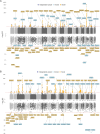Exploring the genomic and transcriptomic profiles of glycemic traits and drug repurposing
- PMID: 40399988
- PMCID: PMC12096723
- DOI: 10.1186/s12929-025-01137-7
Exploring the genomic and transcriptomic profiles of glycemic traits and drug repurposing
Abstract
Background: Type 2 diabetes is an increasingly prevalent metabolic disorder with moderate to high heritability. Glycemic indices are crucial for diagnosing and monitoring the disease. Previous genome-wide association study (GWAS) have identified several risk loci associated with type 2 diabetes, but data from the Taiwanese population remain relatively sparse and primarily focus on type 2 diabetes status rather than glycemic trait levels.
Methods: We conducted a comprehensive genome-wide meta-analysis to explore the genetics of glycemic traits. The study incorporated a community-based cohort of 145,468 individuals and a hospital-based cohort of 35,395 individuals. The study integrated genetics, transcriptomics, biological pathway analyses, polygenic risk score calculation, and drug repurposing for type 2 diabetes.
Results: This study assessed hemoglobin A1c and fasting glucose levels, validating known loci (FN3K, SPC25, MTNR1B, and FOXA2) and discovering new genes, including MAEA and PRC1. Additionally, we found that diabetes, blood lipids, and liver- and kidney-related traits share genetic foundations with glycemic traits. A higher PRS was associated with an increased risk of type 2 diabetes. Finally, eight repurposed drugs were identified with evidence to regulate blood glucose levels, offering new avenues for the management and treatment of type 2 diabetes.
Conclusions: This research illuminates the unique genetic landscape of glucose regulation in Taiwanese Han population, providing valuable insights to guide future treatment strategies for type 2 diabetes.
Keywords: Drug repurposing; Fasting glucose; Genome-wide association study; Glycemic traits; Hemoglobin A1c; Polygenic risk score; Transcriptome-wide association study; Type 2 diabetes.
© 2025. The Author(s).
Conflict of interest statement
Declarations. Ethics approval and consent to participate: The study was conducted according to the guidelines of the Declaration of Helsinki, and approved by the Institutional Review Board of Taipei Medical University (TMU-JIRB N201906005) and Taichung Veterans General Hospital (CE24204A). Consent for publication: Not applicable. Competing interests: The authors declare that they have no competing interests.
Figures





References
-
- Sheen YJ, et al. Trends in prevalence and incidence of diabetes mellitus from 2005 to 2014 in Taiwan. J Formos Med Assoc. 2019;118(Suppl 2):S66-s73. - PubMed
Publication types
MeSH terms
Substances
Grants and funding
LinkOut - more resources
Full Text Sources
Medical

